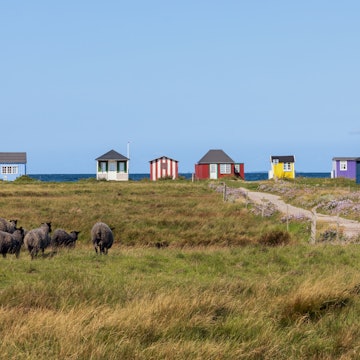

Ørstedsparken. Kiev.Victor/Shutterstock
Summers in Denmark may be short, but the days are long, and in Copenhagen, it's easy to make the most of fine weather in the many parks, gardens, playgrounds, skate parks and dog walking spots across the city's neighborhoods. In fact, it's said that in the center, you're never more than a 15-minute walk from a park. This embarrassment of choice results from the Danish devotion to wholesome living but benefits locals and visitors alike. Check out this list of 10 of the best open spaces in Denmark's capital.
1. Kongens Have
Kongens Have (King’s Garden), the manicured landscape in Copenhagen’s historic heart, is dominated by the 17th-century royal summerhouse, the fairy-tale Rosenborg Slot. Once the royal backyard, it intersperses intricate flowerbeds with statues and fountains bordered by tree-lined walkways leading to pavilions. Former royal outhouses now serve casual eats – try Herkules Pavillonen or Orangeriet's refined setting for smørrebrød. Despite the garden’s formal aesthetic, the vibe is laid-back and well suited for picnics, dog walking and people watching.

2. Botanisk Have
Across Øster Voldgade from Kongens Have, Botanisk Have (Botanical Garden) suggests the wild and natural environments that sourced the exotic plants it contains. Founded in 1874, the garden complex includes a lily-dotted lake and Palmehus (Palm House), rich in tropical flora. The wrought iron staircases inside lead to junglelike canopies, and glassed-in wings host other habitats and a butterfly house. Entry to the garden is free, while the greenhouses require a small fee.
3. Det Kongelige Biblioteks Have
The courtyard of Det Kongelige Bibliotek (Royal Library) was once the site of Christian IV’s naval port, Tøjhushavnen, and the central pond and mooring rings stand as relics of its former life. It’s a peaceful place to sit while hidden within the city center. A statue of the philosopher Søren Kierkegaard presides over the scene, and the entrance to the sculptural Danish Jewish Museum, designed by Polish architect Daniel Libeskind, is off to one corner.
4. Operaparken
Unveiled on the waterfront in 2024, Operaparken (Opera Park) is a highly landscaped space of rare soft greenery amid the sharp-edged harborside architecture. It sits between the lavish Operaen (Opera House) and Papirøen (Paper Island), a development with a public swimming area, a hotel and housing. The garden's multiple levels connect 21,500 sq meters (5 acres) via winding paths and staircases, packing in 600 trees, thousands of plants and a light-filled, glass-walled cafe.

5. Superkilen
Located in multicultural Nørrebro, this avant-garde park is the brainchild of the endlessly inventive local architects Bjarke Ingels Group. It’s divided into three zones: Red Square assembles global play equipment such as Iraqi swings and a Thai boxing ring; Black Square molds monochrome lines around curves and hillocks for skaters; and grassy Green Park is ideal for lounging. Designed to foster community, the park is part playground, part public art.
6. Østre Anlæg
Copenhagen’s medieval center was surrounded by a 17th-century ring of fortifications, most of which were converted into public parks when they were decommissioned in 1870, including this one, with its romantic tree-wrapped lake. At one side, a neoclassical mansion was specially designed for the Hirschsprung, a collection gathered by an art-loving tobacco manufacturer and, almost facing it, the 19th-century Renaissance-style Statens Museum for Kunst (National Gallery).
7. Fælledparken
This large Østerbro park includes not only northern Europe’s largest skate park but also the popular Tower Playground – its climbing equipment modeled on the city’s domes, turrets and spires. The Garden of the Senses is a wonderous maze of fragrance gardens, tactile areas and sculpture. The traffic playground is particularly fabulous. Children under 8 can borrow free bikes (or bring your own) and practice cycling around mini roads with crossings and traffic lights, training for riding solo on the ubiquitous form of transportation in Denmark.

8. Frederiksberg Have
Frederiksberg is a separate leafy enclave within Copenhagen, and its former palace garden is especially lush. It contains the Copenhagen Zoo, grottoes and a Chinese-style bridge as idealized as a willow patterned plate. Frederik VI used to travel the sinuous waterways by boat, greeting people en route: you can take boat tours from Svendsen's Boat Service. Copenhageners love Frederiksberg Have for a jog or a picnic, and you can also visit Haveselskabets Have (Royal Horticultural Society) near the entrance for botanical inspiration. Fasangården, the former royal pheasant garden (where birds were fattened for the hunt), is a lovely restaurant within an 18th-century farmhouse.
9. Ørstedsparken
Close to Copenhagen’s lakes (an equally prime place to amble, with walking and biking trails around the perimeters), this park is another green space created after the decommissioning of the fortifications. It centers around a lake populated by ducks and the odd heron, and has a particularly fine selection of classical-style statuary, commissioned by art-loving Carl Jacobsen (of Carlsberg beer fame). There are also barbecues and two playgrounds.
10. Kalvebod Fælled
Kalvebod Fælled covers 20 sq km (8 sq miles) of the island of Amager, to the west of Copenhagen, with a rambling natural reserve reclaimed from the seabed. Crisscrossed with walking and biking trails, it encompasses marsh, meadows, white sand beaches and wildlife ranging from deer to eagles. The angular Arken Museum of Modern Art building at the edge of the reserve contrasts with the wide-open natural terrain.














